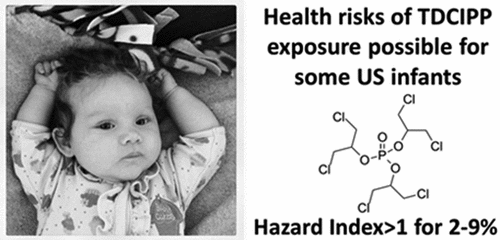当前位置:
X-MOL 学术
›
Environ. Sci. Technol. Lett.
›
论文详情
Our official English website, www.x-mol.net, welcomes your feedback! (Note: you will need to create a separate account there.)
Estimated Tris(1,3-dichloro-2-propyl) Phosphate Exposure Levels for U.S. Infants Suggest Potential Health Risks
Environmental Science & Technology Letters ( IF 10.9 ) Pub Date : 2017-06-23 00:00:00 , DOI: 10.1021/acs.estlett.7b00196 Kate Hoffman 1 , Larisa Gearhart-Serna 1 , Matthew Lorber 2 , Thomas F Webster 3 , Heather M Stapleton 1
Environmental Science & Technology Letters ( IF 10.9 ) Pub Date : 2017-06-23 00:00:00 , DOI: 10.1021/acs.estlett.7b00196 Kate Hoffman 1 , Larisa Gearhart-Serna 1 , Matthew Lorber 2 , Thomas F Webster 3 , Heather M Stapleton 1
Affiliation

|
Tris(1,3-dichloro-2-propyl) phosphate (TDCIPP) has been widely used as a flame retardant and is commonly detected in environmental samples. Biomonitoring studies relying on urinary metabolite levels [i.e., bis(1,3-dichloro-2-propyl) phosphate (BDCIPP)] demonstrate widespread exposure, but TDCIPP intake is unknown. Intake data are critical components of meaningful risk assessments and are needed to elucidate the potential health impacts of TDCIPP exposure. Using biomonitoring data, we estimated TDCIPP intake for infants aged 2−18 months. Children were recruited from central North Carolina (n = 43, recruited in 2014 and 2015), and spot urine samples were analyzed for BDCIPP. TDCIPP intake rates were estimated using daily urine excretion and the fraction of TDCIPP excreted as BDCIPP in urine. Daily TDCIPP intake estimates ranged from 0.01 to 15.03 μg kg–1 day–1 for children included in our assessment, with some variation depending on model assumptions. The U.S. Consumer Products Safety Commission previously established an acceptable daily intake of 5 μg kg–1 day–1 for non-cancer health risks. Depending on modeling assumptions, we found that 2–9% percent of infants had TDCIPP intake estimates above this threshold. Our results indicate that current TDCIPP exposure levels could pose health risks for highly exposed infants.
中文翻译:

美国婴儿的三(1,3-二氯-2-丙基)磷酸盐估计暴露水平表明潜在的健康风险
三(1,3-二氯-2-丙基)磷酸酯(TDCIPP)已被广泛用作阻燃剂,通常在环境样品中检测到。依赖于尿代谢物水平 [即双(1,3-二氯-2-丙基)磷酸酯 (BDCIPP)] 的生物监测研究表明广泛接触,但 TDCIPP 摄入量未知。摄入数据是有意义的风险评估的关键组成部分,需要阐明 TDCIPP 暴露的潜在健康影响。我们使用生物监测数据估算了 2-18 个月婴儿的 TDCIPP 摄入量。儿童是从北卡罗来纳州中部招募的(n= 43,于 2014 年和 2015 年招募),并对现场尿液样本进行 BDCIPP 分析。使用每日尿液排泄量和 TDCIPP 在尿液中作为 BDCIPP 排出的分数来估计 TDCIPP 摄入率。对于我们评估中包括的儿童,每日 TDCIPP 摄入量估计范围为 0.01 至 15.03 μg kg –1天–1,根据模型假设存在一些差异。美国消费品安全委员会此前规定,对于非癌症健康风险,可接受的每日摄入量为 5 μg kg –1天–1。根据建模假设,我们发现 2-9% 的婴儿的 TDCIPP 摄入量估计值高于此阈值。我们的结果表明,当前的 TDCIPP 暴露水平可能对高度暴露的婴儿构成健康风险。
更新日期:2017-07-12
中文翻译:

美国婴儿的三(1,3-二氯-2-丙基)磷酸盐估计暴露水平表明潜在的健康风险
三(1,3-二氯-2-丙基)磷酸酯(TDCIPP)已被广泛用作阻燃剂,通常在环境样品中检测到。依赖于尿代谢物水平 [即双(1,3-二氯-2-丙基)磷酸酯 (BDCIPP)] 的生物监测研究表明广泛接触,但 TDCIPP 摄入量未知。摄入数据是有意义的风险评估的关键组成部分,需要阐明 TDCIPP 暴露的潜在健康影响。我们使用生物监测数据估算了 2-18 个月婴儿的 TDCIPP 摄入量。儿童是从北卡罗来纳州中部招募的(n= 43,于 2014 年和 2015 年招募),并对现场尿液样本进行 BDCIPP 分析。使用每日尿液排泄量和 TDCIPP 在尿液中作为 BDCIPP 排出的分数来估计 TDCIPP 摄入率。对于我们评估中包括的儿童,每日 TDCIPP 摄入量估计范围为 0.01 至 15.03 μg kg –1天–1,根据模型假设存在一些差异。美国消费品安全委员会此前规定,对于非癌症健康风险,可接受的每日摄入量为 5 μg kg –1天–1。根据建模假设,我们发现 2-9% 的婴儿的 TDCIPP 摄入量估计值高于此阈值。我们的结果表明,当前的 TDCIPP 暴露水平可能对高度暴露的婴儿构成健康风险。


























 京公网安备 11010802027423号
京公网安备 11010802027423号